While most indoor bonsai species struggle to survive below 50°F (10°C), you’ll find that certain varieties actually thrive in typical home conditions. Your success with indoor bonsai depends on selecting species that naturally adapt to consistent temperatures and lower light levels. From the cascading branches of a Ficus Microcarpa to the striking silhouette of a Japanese White Pine, each indoor variety offers distinct growing requirements and aesthetic appeal that you’ll soon discover.
Contents
Japanese Juniper
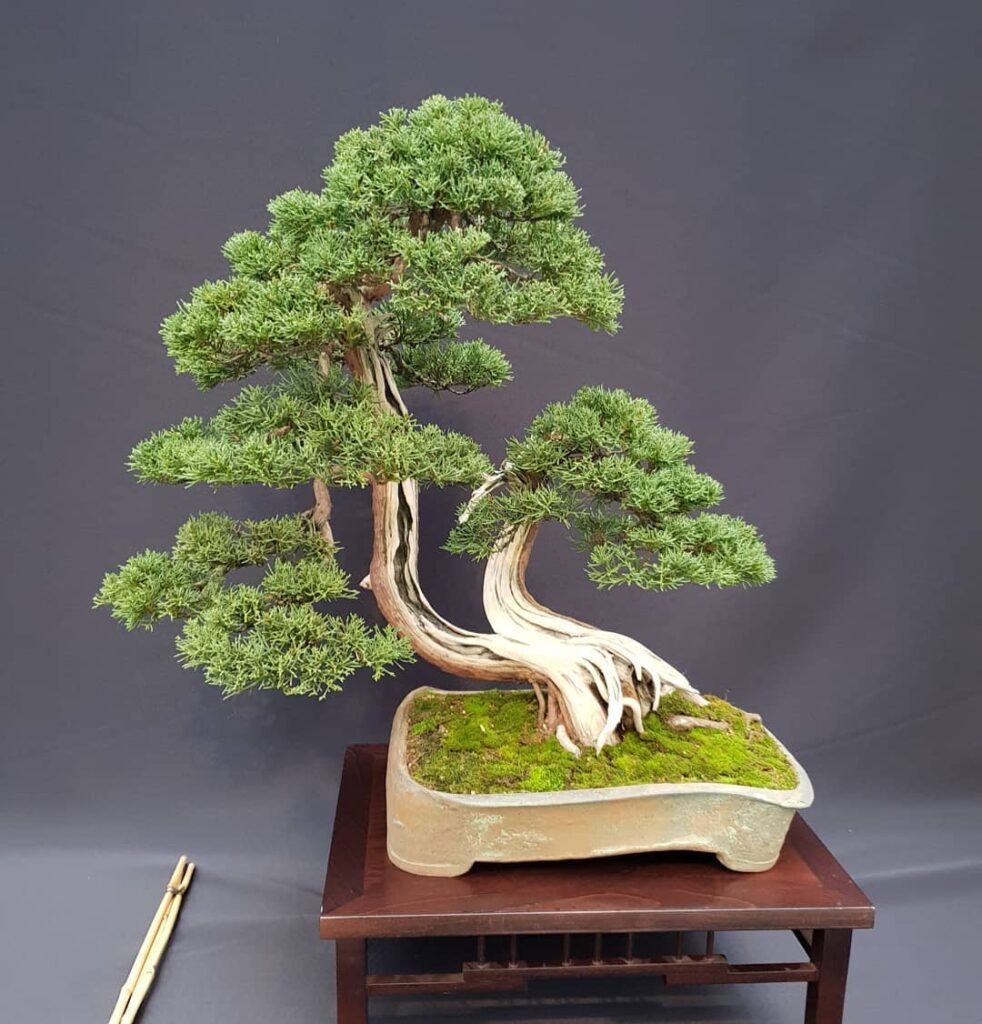
The Umbrella-shaped Japanese Juniper (Juniperus chinensis) is a visually striking bonsai variety characterized by its broad, flattened crown that resembles an umbrella. This architectural form is achieved through careful pruning and training of the naturally upright branches to create horizontal layers. The dense, blue-green foliage consists of both needle-like and scale-like leaves, providing interesting texture year-round. When properly maintained, this style can reach 1-2 feet in height, making it an excellent choice for indoor display.
- Light: Bright indirect sunlight, with 4-6 hours of direct morning sun; protect from intense afternoon sun
- Water: Allow top inch of soil to dry between waterings; reduce frequency in winter
- Soil: Well-draining bonsai mix with equal parts akadama, pumice, and lava rock
- Humidity: Moderate to high (40-60%); mist foliage regularly
- Temperature: 60-75°F (15-24°C); can tolerate brief periods of cooler temperatures
- Fertilizer: Balanced liquid fertilizer every 2-4 weeks during growing season
- Pruning: Regular trimming in spring and summer to maintain umbrella shape
Weeping Chinese Elm

The Weeping Chinese Elm (Ulmus parvifolia) is a popular indoor bonsai choice known for its graceful drooping branches and small, dark green leaves that turn golden-yellow in fall. This hardy tree features distinctive mottled bark that becomes increasingly textured with age, creating an attractive flaking pattern of gray, green, orange, and brown colors. Its malleable branches and rapid growth make it especially suitable for bonsai training, while its forgiving nature and resilience to varying conditions make it ideal for beginners.
- Light: Bright indirect sunlight; can tolerate some direct morning sun; protect from intense afternoon sun
- Water: Keep soil consistently moist but not waterlogged; water when top inch of soil feels dry
- Soil: Well-draining bonsai mix with good moisture retention; mix of akadama, pumice, and organic matter
- Humidity: Moderate to high; benefits from regular misting
- Temperature: 60-75°F (15-24°C); can survive brief periods of cold
- Fertilizer: Balanced liquid fertilizer every two weeks during growing season
- Pruning: Regular trimming throughout growing season to maintain shape
- Repotting: Every 2-3 years in spring
Dwarf Jade
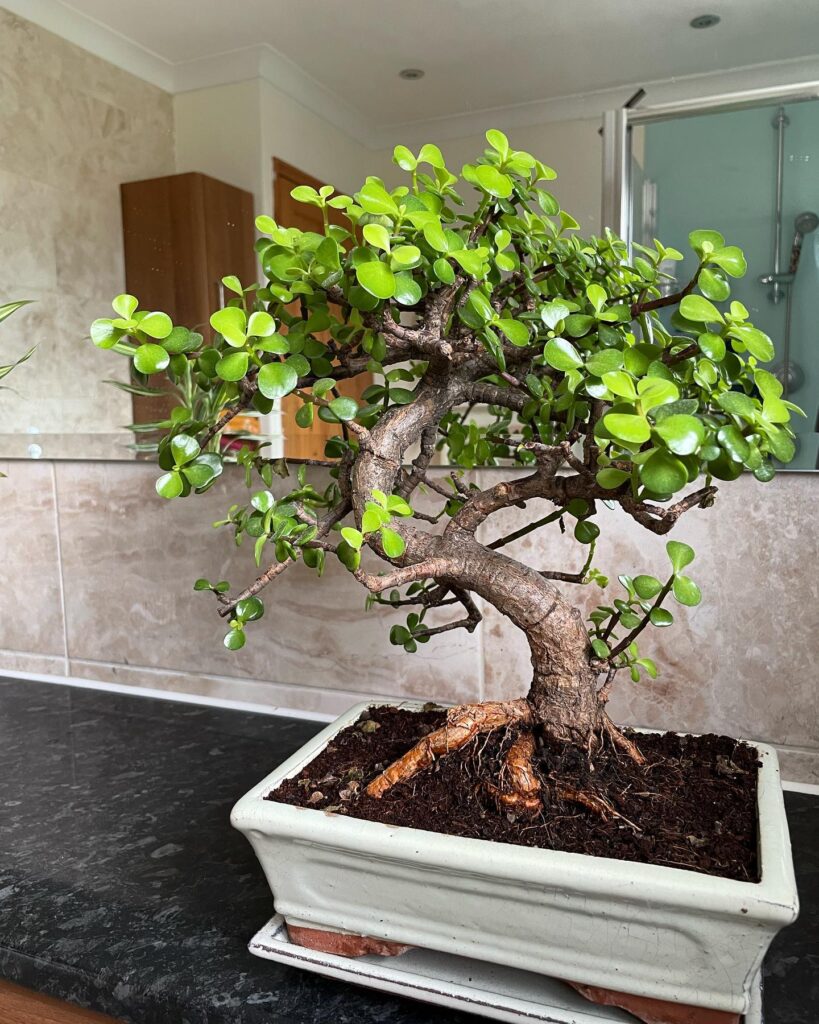
The Flowering Dwarf Jade (Portulacaria afra) is a popular indoor bonsai choice known for its small, round leaves and thick trunk that develops an aged appearance over time. While not a true jade plant, this succulent species produces delicate pink flowers when properly cared for and features branches that can be easily wired and shaped. Its compact growth pattern and drought-tolerant nature make it particularly suitable for bonsai cultivation in indoor environments.
- Light: Bright, indirect sunlight with some direct morning sun; protect from intense afternoon sun
- Water: Allow soil to dry between waterings; reduce watering in winter
- Soil: Well-draining bonsai mix with added grit or sand
- Temperature: 60-75°F (15-24°C); protect from frost
- Humidity: Tolerates low humidity levels
- Fertilizer: Feed monthly during growing season with balanced fertilizer
- Pruning: Regular pruning throughout growing season to maintain shape
- Repotting: Every 2-3 years in spring
Ficus Microcarpa
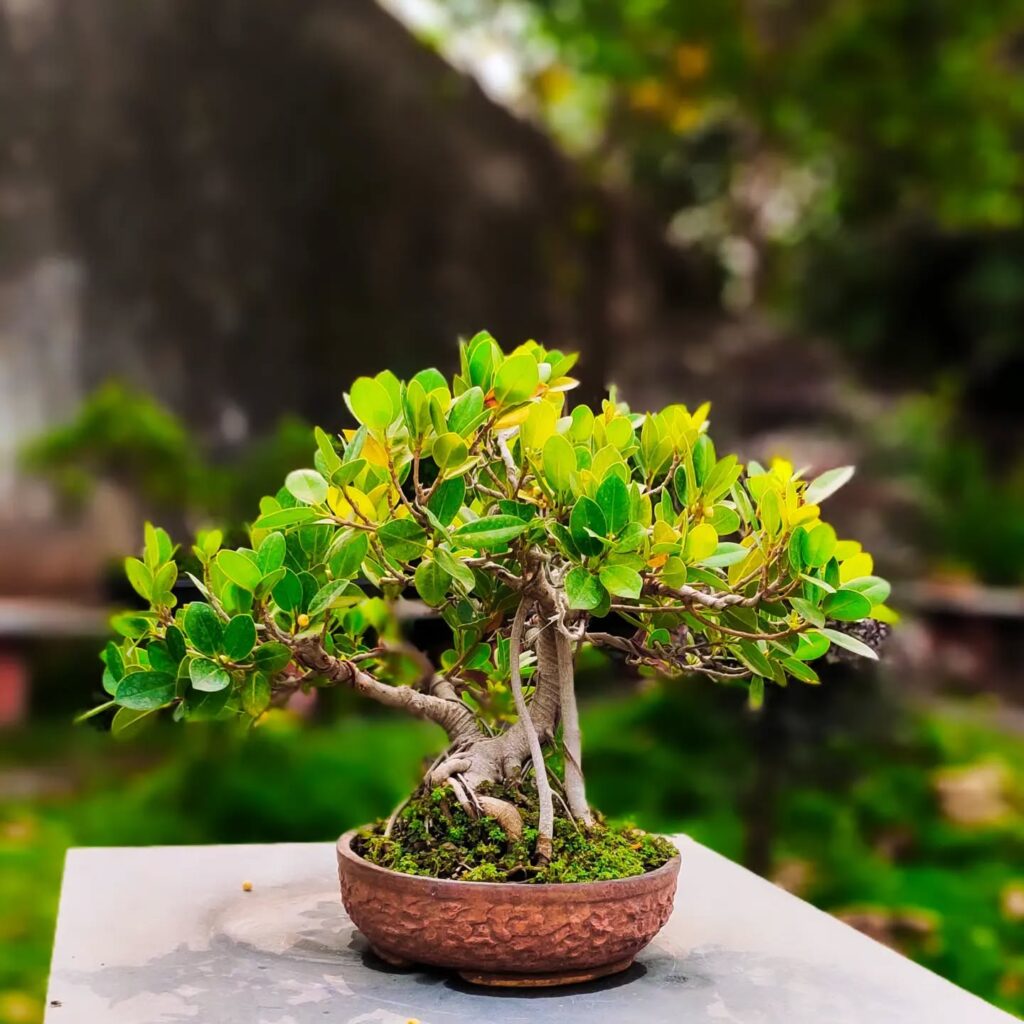
The Cascading Ficus Microcarpa is a popular bonsai variety that naturally grows with a dramatic downward-flowing appearance, similar to a waterfall. Its small, oval-shaped leaves and ability to develop aerial roots make it an attractive choice for indoor bonsai cultivation. When trained as a cascade style, the main trunk and branches grow downward below the base of the pot, creating an elegant and striking aesthetic that mimics trees growing on cliff faces in nature.
- Light: Bright, indirect sunlight; can tolerate some direct morning sun but protect from harsh afternoon rays
- Water: Keep soil consistently moist but not waterlogged; water when top inch of soil feels dry
- Humidity: 50-70% relative humidity; mist leaves regularly or use humidity tray
- Soil: Well-draining bonsai mix with equal parts akadama, pumice, and organic potting soil
- Temperature: 65-85°F (18-29°C); protect from cold drafts
- Fertilizer: Feed every 2-4 weeks during growing season with balanced liquid fertilizer
- Pruning: Regular trimming to maintain cascade form and control growth density
- Container: Deeper than standard bonsai pots to accommodate cascading growth
Japanese White Pine
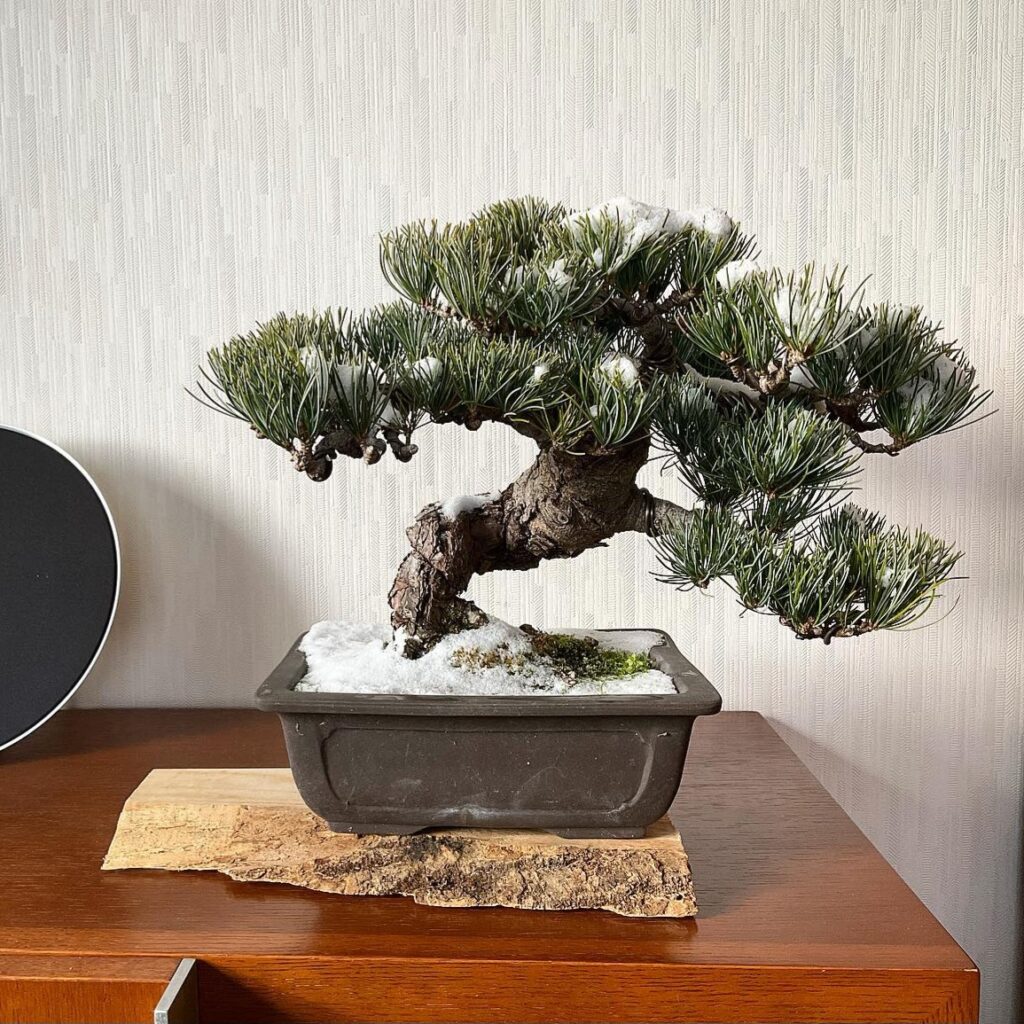
The Japanese White Pine (Pinus parviflora) is a highly respected bonsai species known for its elegant silhouette and delicate needles arranged in clusters of five. This conifer naturally develops an appealing asymmetrical form with gracefully drooping branches and silvery-blue-green foliage that creates a soft, ethereal appearance. When styled as a bonsai, it responds well to wiring and pruning, making it possible to achieve the classic windswept or cascading forms that are emblematic of traditional Japanese bonsai artistry.
- Light: Bright indirect sunlight; can tolerate some direct morning sun; protect from intense afternoon sun
- Water: Allow soil to dry between waterings; water sparingly in winter; less frequent watering than most bonsai
- Soil: Well-draining bonsai mix with added grit or pumice; 50/50 mix of organic and inorganic materials
- Temperature: Prefers warm conditions between 65-80°F (18-27°C); protect from frost
- Humidity: Tolerates average indoor humidity; no special requirements
- Fertilizer: Feed with balanced fertilizer at half strength during growing season
- Pruning: Trim regularly to maintain shape; can be pruned year-round
- Repotting: Every 2-3 years in spring
Dwarf Schefflera Bonsai

The Dwarf Schefflera Bonsai, derived from the Schefflera arboricola species, makes an excellent indoor bonsai choice due to its naturally compact growth pattern and distinctive umbrella-shaped leaf formations. This tropical plant features dark green, glossy compound leaves arranged in a circular pattern, creating an appealing cascade effect when trained as a bonsai. While smaller than its full-sized relative, the Dwarf Schefflera still maintains the characteristic elegant branching structure and can be shaped into various traditional bonsai styles, particularly informal upright and cascade forms.
- Light: Bright, indirect sunlight; can tolerate moderate shade but prefers consistent light; avoid direct afternoon sun
- Water: Keep soil consistently moist but not waterlogged; water when top inch of soil feels dry
- Soil: Well-draining bonsai mix with added organic matter; pH 6.0-6.5
- Temperature: 60-80°F (15-27°C); protect from cold drafts
- Humidity: Moderate to high; benefits from regular misting
- Fertilizer: Balanced, water-soluble fertilizer every 2-4 weeks during growing season
- Pruning: Regular trimming to maintain compact shape; can handle heavy pruning
- Repotting: Every 2-3 years in spring
Dwarf Gardenia

The Dwarf Gardenia is a compact, slow-growing bonsai variety prized for its fragrant white blooms. This evergreen plant typically reaches heights of 2-3 feet when grown as a bonsai, making it ideal for indoor cultivation. Its glossy leaves feature irregular patterns of white or yellow alongside deep green, creating visual interest even when not in bloom. The plant produces highly fragrant, white, rose-like flowers primarily in spring and summer, though it may bloom sporadically throughout the year under favorable conditions.
- Light: Bright, indirect sunlight; morning sun and afternoon shade ideal; avoid harsh direct sunlight
- Water: Keep soil consistently moist but not waterlogged; water when top inch of soil feels dry
- Humidity: High humidity (50% or higher); use humidity tray or regular misting
- Temperature: 65-75°F (18-24°C); protect from cold drafts
- Soil: Well-draining, acidic soil mix (pH 5.0-6.0); combine regular bonsai soil with peat moss
- Fertilizer: Monthly feeding during growing season with acid-loving plant fertilizer
- Pruning: Regular trimming to maintain shape; prune after flowering
- Repotting: Every 2-3 years in spring before new growth begins
Japanese Maple
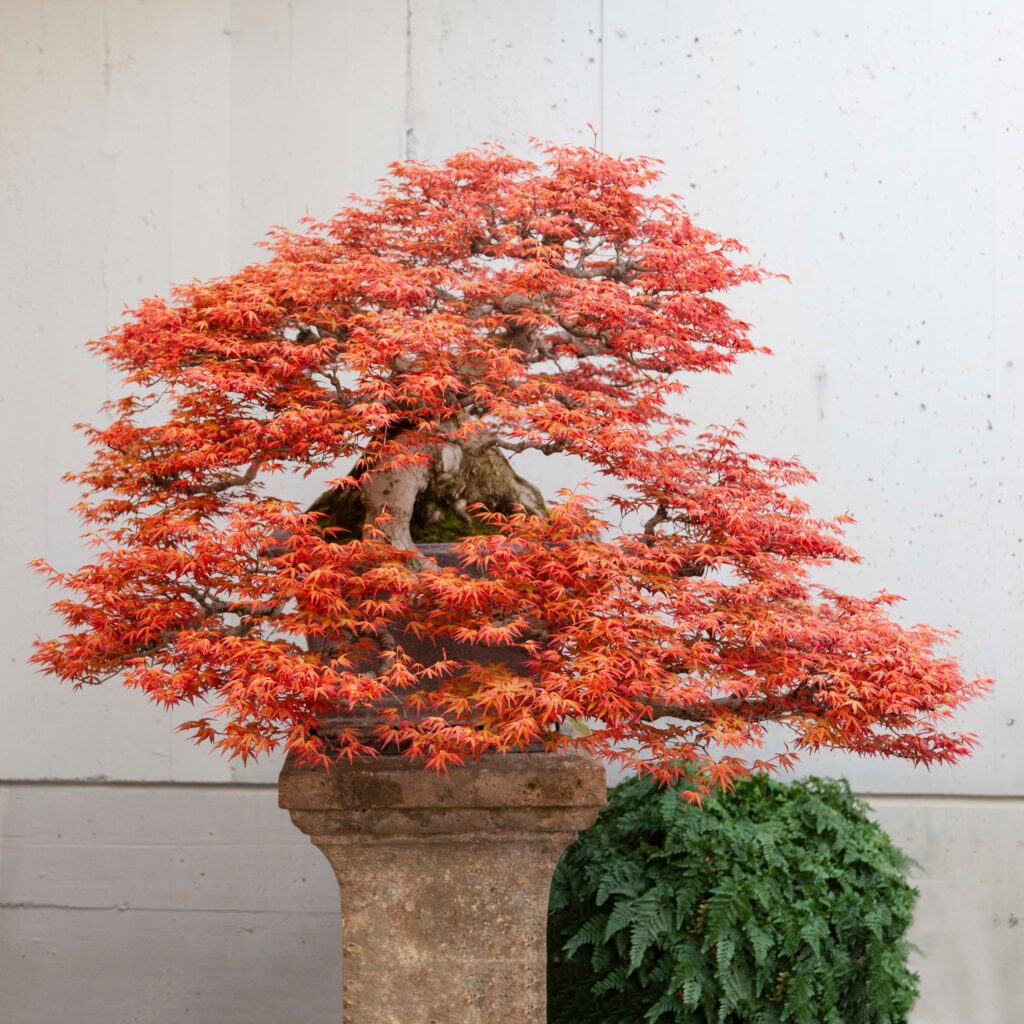
The Japanese Maple Bonsai is a enchanting variety characterized by its contorted branches and delicate, palmate leaves that change colors throughout the seasons. Known scientifically as Acer palmatum, this cultivar naturally develops twisted and gnarled branches, making it an excellent choice for dramatic bonsai compositions. Its leaves shift from vibrant spring greens to deep burgundy in summer, followed by brilliant orange and red autumn colors before dropping in winter, creating year-round visual interest.
- Light: Bright, indirect sunlight; morning sun with afternoon shade; protect from intense afternoon sun
- Water: Keep soil consistently moist but not waterlogged; water when top inch of soil feels dry
- Soil: Well-draining bonsai mix with equal parts akadama, pumice, and organic potting soil
- Humidity: Moderate to high; benefits from regular misting
- Temperature: 20-70°F (-6 to 21°C); requires winter dormancy period
- Fertilizer: Balanced feed (10-10-10) every two weeks during growing season
- Pruning: Regular trimming in spring and summer to maintain shape
- Repotting: Every 2-3 years in early spring before new growth appears
Chinese Sweet Plum

The Miniature Chinese Sweet Plum (Sageretia theezans) is a popular indoor bonsai choice known for its tiny leaves, delicate branches, and compact growth pattern. This evergreen tree features small, oval-shaped leaves with serrated edges and can produce tiny white flowers in spring, followed by small purple-black berries. When grown as a bonsai, it typically reaches heights of 6-12 inches, making it ideal for indoor display on windowsills or desks.
- Light: Bright indirect sunlight; morning sun is beneficial, but protect from harsh afternoon sun
- Water: Keep soil consistently moist but not waterlogged; water when top layer feels dry
- Humidity: Prefers high humidity; regular misting or humidity tray recommended
- Temperature: 60-75°F (15-24°C); protect from cold drafts
- Soil: Well-draining bonsai mix with good moisture retention
- Fertilizer: Feed every two weeks during growing season with balanced bonsai fertilizer
- Pruning: Regular trimming throughout growing season to maintain shape
- Location: Indoor placement near window, away from heating/cooling vents
Boxleaf Eugenia
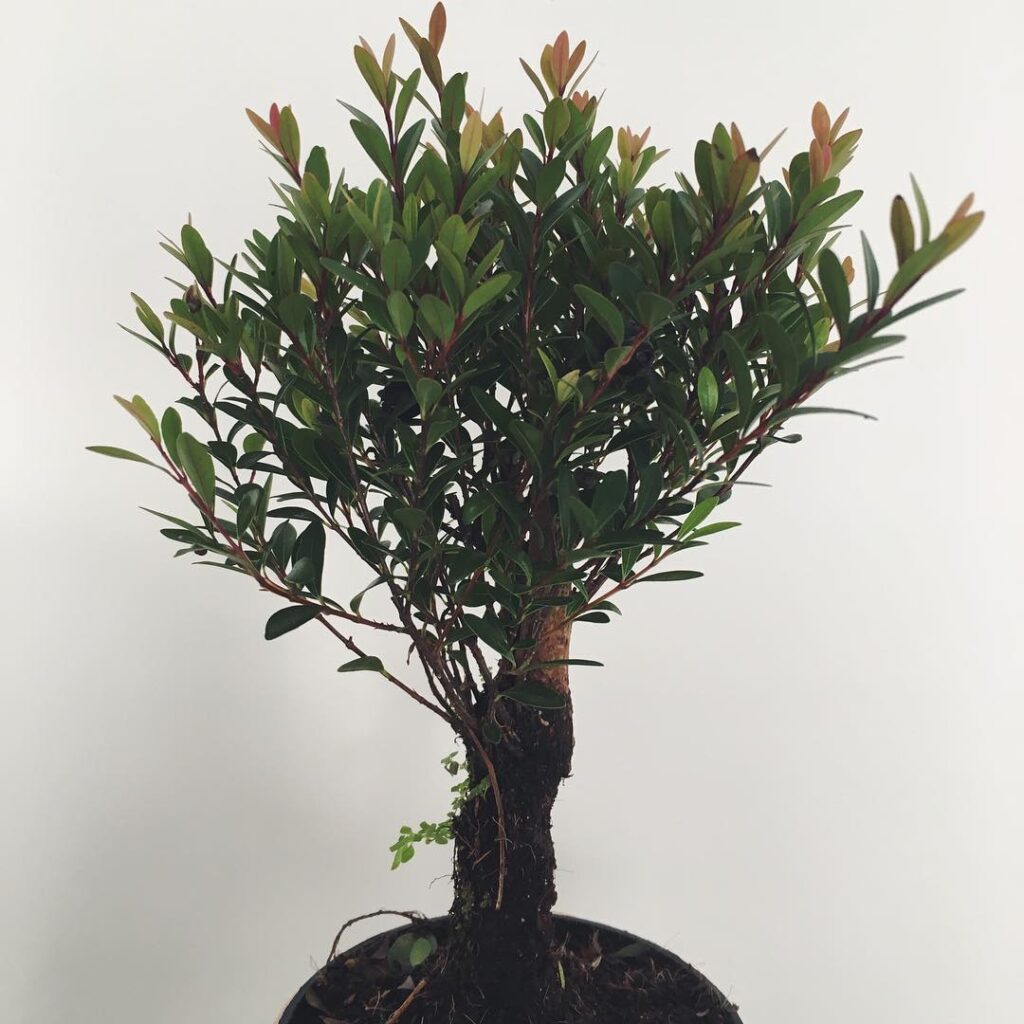
Boxleaf Eugenia is a compact, evergreen shrub or small tree known for its dense, bushy growth and fine-textured foliage that resembles boxwood. Native to China, Taiwan, and parts of Southeast Asia, this species is often used for hedging, bonsai, and ornamental landscaping. Its small, dark green leaves contrast beautifully with young reddish foliage, while its powderpuff-like flowers and small, berry-like fruits add seasonal interest.
- Light: Prefers full sun to partial shade; thrives in well-lit environments
- Water: Moderate watering; keep soil moist but well-drained
- Soil: Well-draining, organic-rich soil with good moisture retention
- Temperature: 60-80°F (15-27°C)
- Humidity: Moderate humidity levels; tolerates some dryness
- Fertilizer: Feed every 6-8 weeks with balanced fertilizer during the growing season
- Container: Suitable for pots, hedging, and bonsai cultivation
Norfolk Island Pine

The Norfolk Island Pine (Araucaria heterophylla) is a coniferous tree that makes an elegant upright bonsai specimen despite not being a traditional bonsai species. With its symmetrical, tiered branches and soft needles, this tropical plant naturally grows in a pyramidal shape and can be maintained as a small indoor tree. While it can reach towering heights in its native habitat, when grown as an indoor bonsai it typically stays between 3-6 feet tall, featuring delicate, inward-curving branches that create an appealing architectural form.
- Light: Bright, indirect sunlight; can tolerate some direct morning sun but protect from harsh afternoon rays
- Water: Keep soil consistently moist but not waterlogged; water when top inch of soil feels dry
- Humidity: Requires high humidity (50% or higher); mist regularly or use humidity tray
- Temperature: 60-70°F (15-21°C); protect from cold drafts and sudden temperature changes
- Soil: Well-draining, slightly acidic potting mix with added perlite and sand
- Fertilizer: Feed with balanced, water-soluble fertilizer every 2-3 weeks during growing season
- Pruning: Minimal pruning needed; remove dead or yellowing branches as needed
- Repotting: Every 2-3 years in spring
Dwarf Cherry Blossom Bonsai
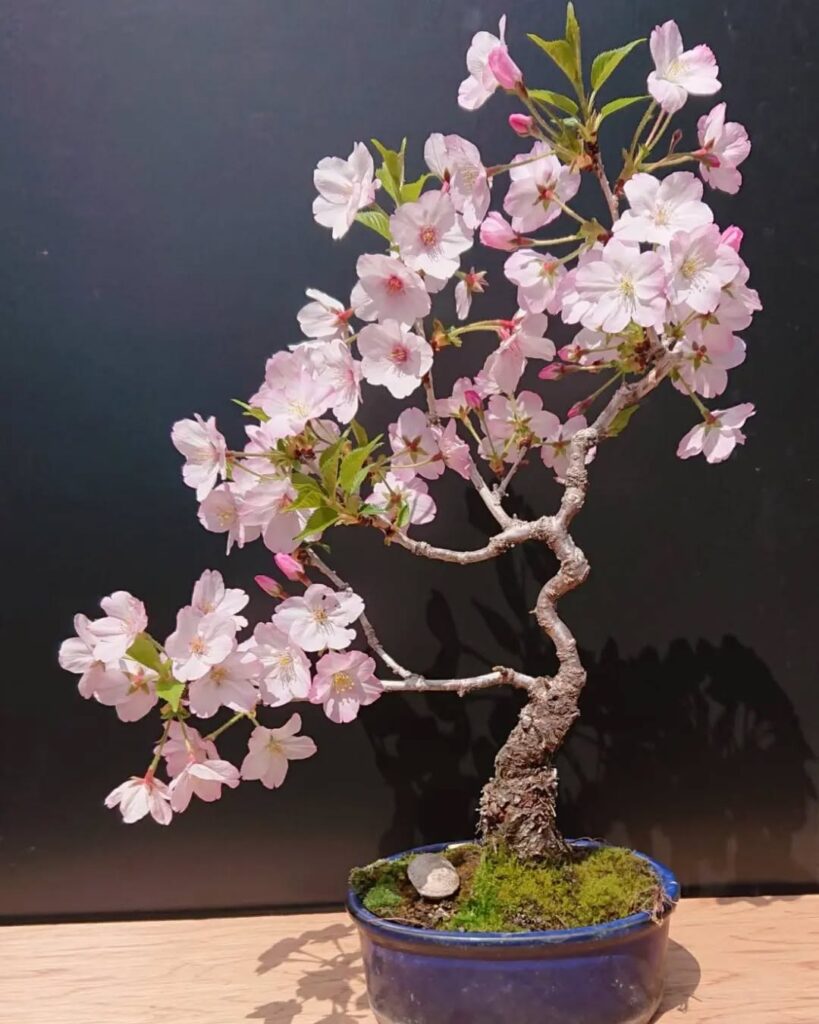
The Dwarf Cherry Blossom Bonsai is a miniature version of the ornamental cherry tree, known for its delicate pink or white blossoms that appear in spring. This variety typically grows to around 6-12 inches tall when maintained as a bonsai and features the characteristic cherry tree bark patterns and branching structure. The blooming period, though brief, creates a stunning display that makes it a popular choice for indoor bonsai enthusiasts, while its compact size makes it well-suited for windowsills and small spaces.
- Light: Bright, indirect sunlight; morning sun is beneficial, but protect from harsh afternoon rays
- Water: Keep soil consistently moist but not waterlogged; water when top inch of soil feels dry
- Humidity: 50-60% relative humidity; use humidity tray or regular misting
- Temperature: 65-75°F (18-24°C); avoid cold drafts
- Soil: Well-draining, slightly acidic soil mix (pH 6.0-6.5) with high organic content
- Fertilizer: Feed monthly during growing season with balanced, water-soluble fertilizer
- Pruning: Regular trimming throughout growing season to maintain shape and promote bushiness
- Repotting: Every 2-3 years in early spring
